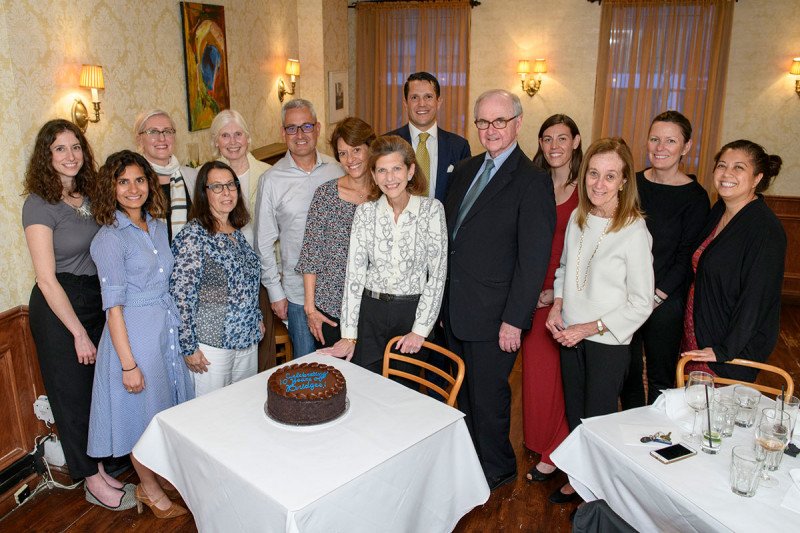
The Bridges team at their tenth anniversary dinner. From left: Jennifer Castoro, Nirupa Raghunathan, Alexandria Woodside, Ellen Greenfield, Clare Thomas, Patrick Dooley, Joanne Candela, Eileen Gould, Mario Lacouture, Robert Dwyer, Meghan Newcomer, Mary McCabe, Stacie Corcoran, and Larissa Regala. Not pictured: Rick Dewitt and David Pfister
Since its inception, Bridges has connected and inspired people who have faced cancer and the challenges that come with it. The quarterly publication is written by survivors for survivors. This June, it will celebrate its tenth anniversary.
We spoke with Eileen Gould, the patient editor for Bridges and a three-time cancer survivor. She reflects on the newsletter’s early days and her hopes for what’s next.
Can you tell me about the beginning of Bridges? How did it start?
I was diagnosed with Hodgkin lymphoma in 1978. At that time, there were hardly any resources for people with cancer. I was a patient at Stanford, and I wrote a few articles about survivorship.
Many years later, my husband was successfully treated at MSK for head and neck cancer, and I wanted to give back. I contacted the volunteer office and learned about a possible project in the Division of Survivorship and Supportive Care. I thought survivors should be able to share their stories with those who were newly diagnosed.
I had the idea of starting a newsletter at MSK in which survivors could write about their experiences, and we’d compile, publish, and distribute them. I didn’t have experience with this, other than writing those two articles.
So I spoke to Mary McCabe, who was Director of the Cancer Survivorship Initiative. She had a similar idea, and we decided to start this together. In March 2008, we started working on it along with a designer in the Department of Marketing & Communications, Larissa Regala. We published our first issue in June 2008.
Where did the name Bridges come from?
The bridge represents the goal of our publication. We hope that we are able to connect people. When Bridges first started, a young man named Duane Bailey-Castro was asked to be on our advisory committee. He was an avid photographer and Hodgkin lymphoma patient and loved to take photographs of the bridges around New York City. So we used one of his photos of the Brooklyn Bridge as our cover.
Who decides what survivorship issues are covered in each issue?
We have an advisory committee made up of doctors, nurses, volunteers, patients, caregivers, and more. Every other month we meet to discuss topics for the upcoming issue. We have recurring sections — Ask the Survivor (an interview) and Ask the Professional (an interview with an MSK doctor or nurse) — and then three or four stories written by survivors. Those can be about anything they want.
What’s been the most gratifying part of your work with Bridges?
When we started, I wasn’t sure we would have enough stories to last ten years. I’m inspired by all of the writers that submit to Bridges. Whenever I read a story written by a younger person, I feel a bit of a special connection. I was diagnosed with cancer when I was 21 and hardly knew anything about cancer. No one in my family had cancer before me. It changed my life forever.
What’s next for Bridges? What do you hope the next ten years brings?
We now have more than 3,500 subscribers, and I hope we can continue to grow that number. Even more importantly, though, I hope that we continue to hear from survivors who want to share their story of hope and survival.
The cancer community is so much more aware of survivors today compared with how it was when I was first diagnosed. At MSK especially, it’s clear that there has been a focused effort to make survivorship an important part of the cancer experience.
What advice do you have for someone who wants to write for Bridges?
Anyone who has cancer now or has had cancer can submit their story to Bridges. My main advice is not to be worried if you don’t consider yourself a good writer. If you have a story or just an idea but don’t know how to put it on paper, we have people on our advisory committee who can help. Every story is a good story because the person is here to tell it.


